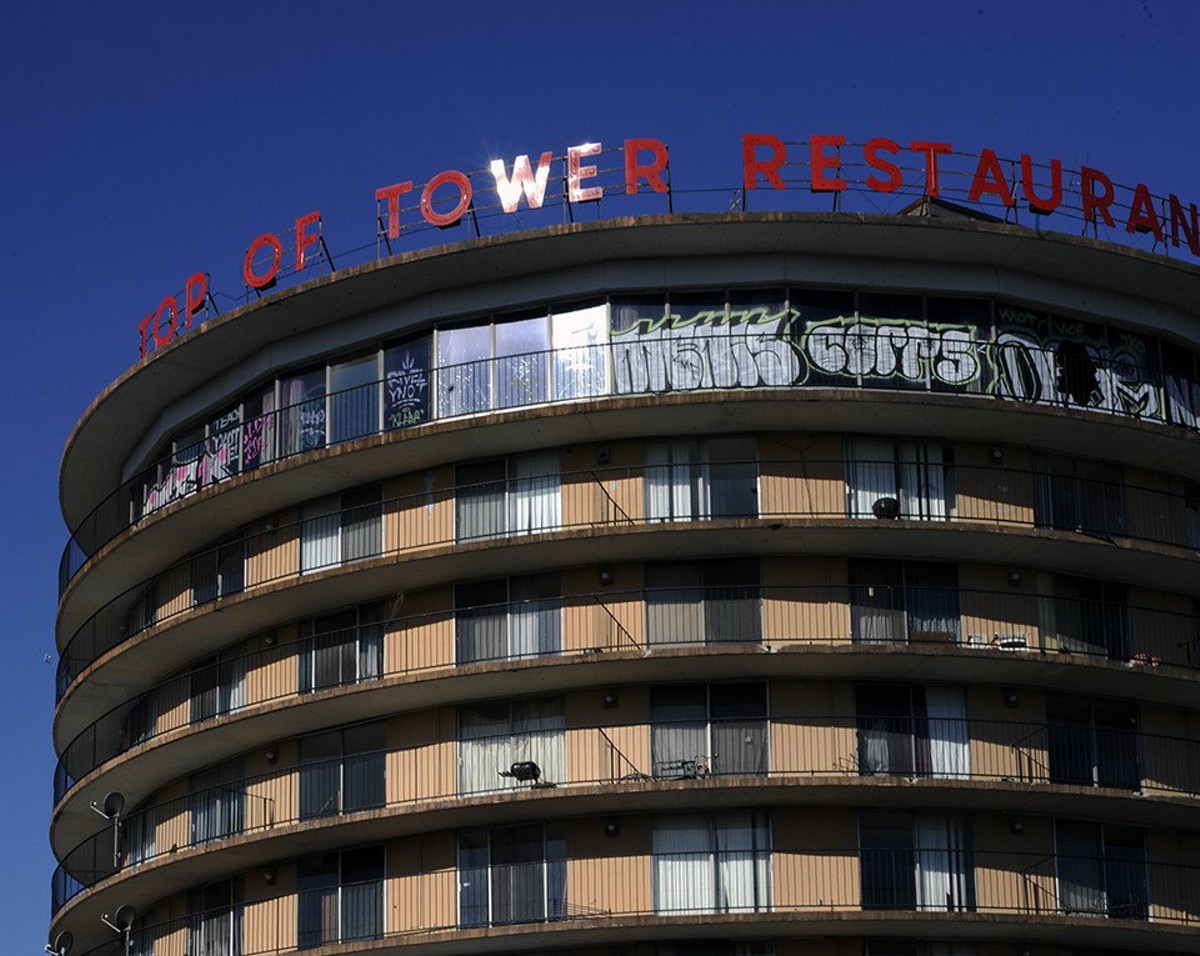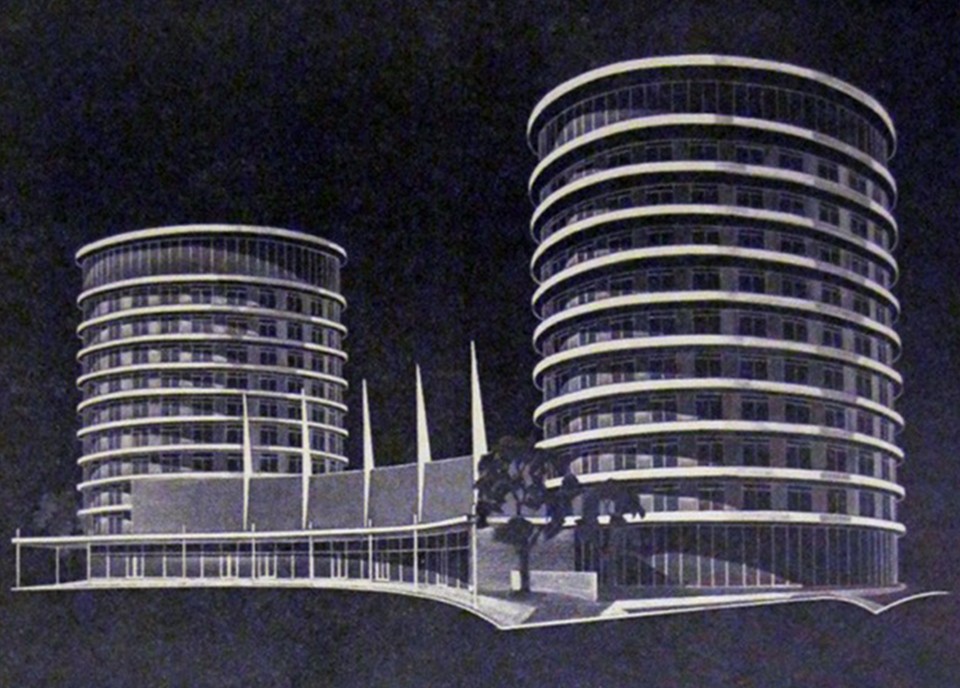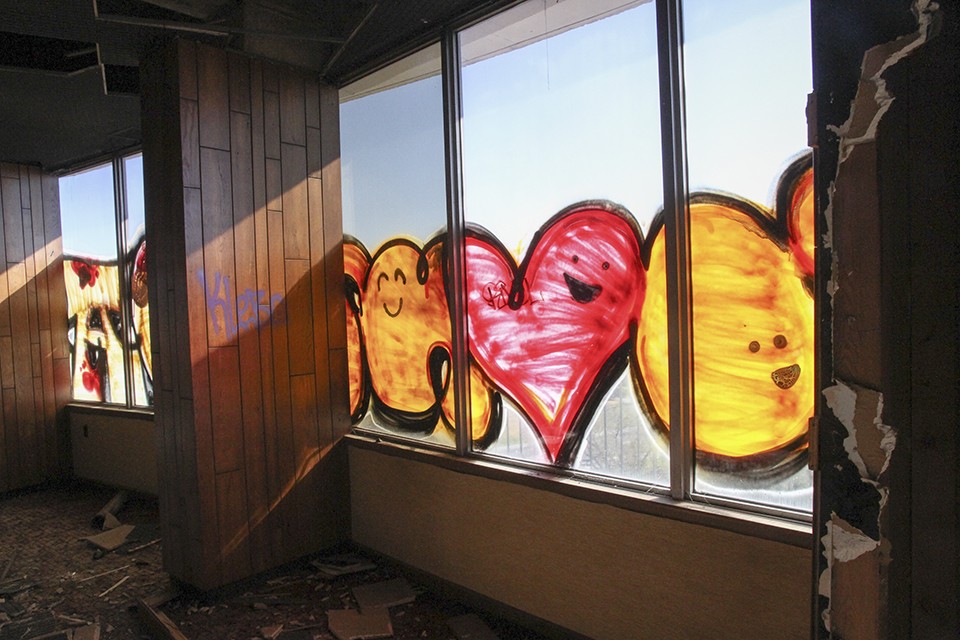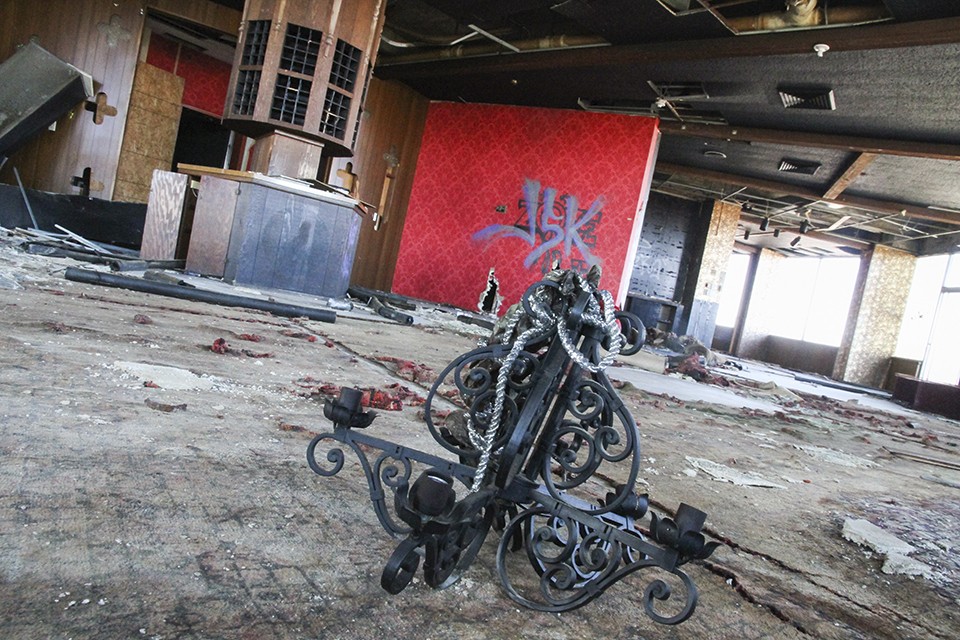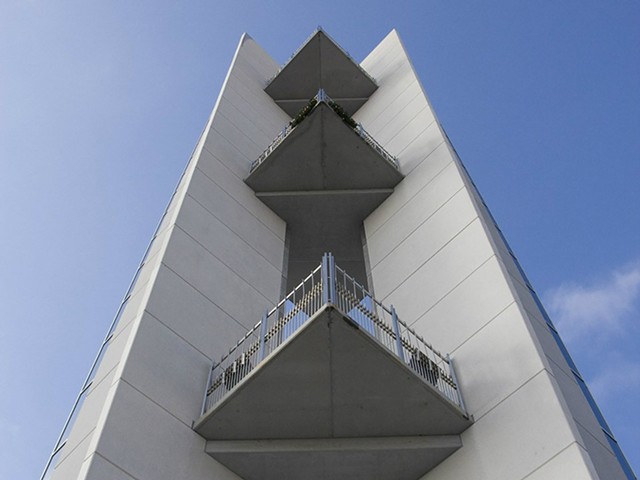The Lewis & Clark Tower's circular presence on the north-county landscape is more than a bit exaggerated in scale, its mid-century modern design a bold reminder of architectural notions from another time. Surrounded by single-story, frame-and-brick ranch homes on one side, roads and parking lots on the other three, the unusual 10-story cylinder cuts a sharp contrast to its neighbors.
A landmark at the intersection of Lewis and Clark Boulevard and Chambers Road since 1965, the Tower showcased its human element for years, with its small terraces filled by BBQ grills, satellite dishes and clotheslines. These small touches suggested that an alien craft hadn't, in fact, landed onto the anchor position of a suburban strip mall. Today, though, a drive-by visitor wouldn't be blamed for not knowing what the structure was at the height of its use. The only real clue above graffitied walls and broken windows is the signage on its roof: Top of Tower Restaurant.
See also: 15 Haunting Photos from Inside the Tower
It was more than a restaurant, of course. In its heyday, the Tower was the ultimate suburban magnet, a destination for moviegoers, grocery shoppers and bowlers, with a residential component that spoke to the '60s idyll of having all your needs bundled together, with ample parking for all. The Tower really mattered to north county then, a robust engine of commerce, a home to dozens of residents and a place that said, "This is how we'll live, play and shop in the years to come."
We didn't.
The structure has been abandoned for not quite a half-decade, but the death signals came long, long before the town of Moline Acres issued the final condemnation orders in 2014. In the years before that, the condos and businesses inside had suffered internal strife within the condo association, disputes with out-of-state ownership and a general lack of upkeep, with various units losing access to essentials like working elevators and hot water. By then, the in-house pool had long since closed and the on-site movie theater and bowling alley were solely memories.
Today a few seemingly operable cell phone towers exist on the rooftop, the only functional items within the Tower's footprint. And while several long-running businesses remain active in the adjacent plaza, questions about its future are prevalent. Answers are much more elusive.
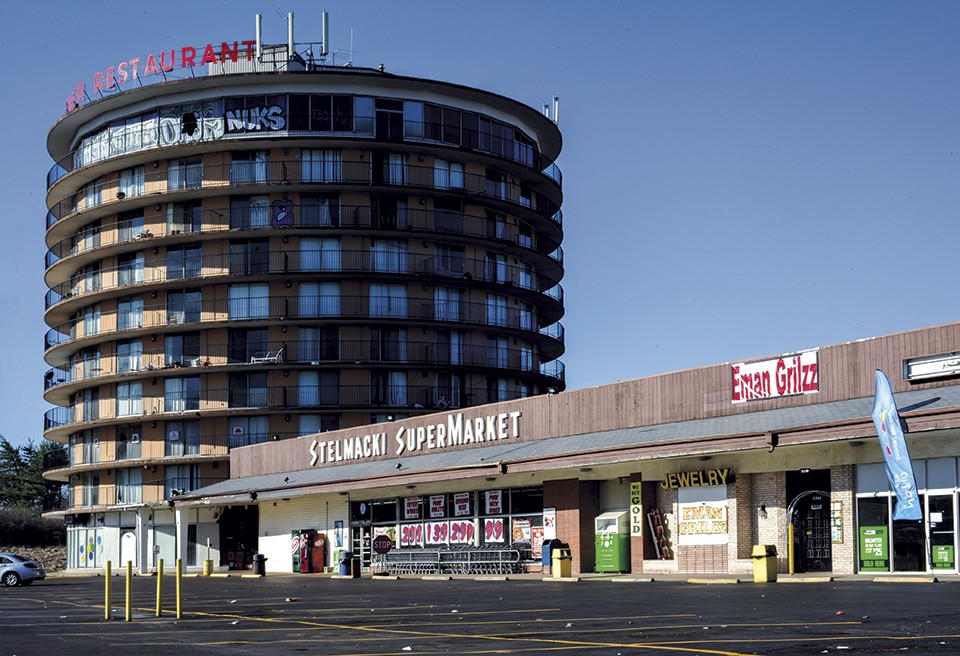
Tom Stelmacki is a manager at the business closest to the Tower, Stelmacki's Family Market, an apt name. It's an old-school grocery in the absolute best sense; it's tidy and trim, with design elements that haven't changed a lot since the store opened in 1965, like the wooden, farm-like shingles hanging above the meat department, where Tom's brother Mike works.
Tom Stelmacki's memories of decades spent working in the plaza mirror those of countless north county residents.
"It was a hustling and bustling area right here," he says. "The Top of Tower was one of the best restaurants in all of north county. I remember the limos pulling up and dropping people off on Friday and Saturday nights. I remember the kids going to proms and dinner dances there. You had the bowling alley, the movie theater. It was all right here and when that was all going, it was bustling, busy."
As the businesses up and down the retail plaza flourished, then receded, then hung in, Stelmacki's thrived, becoming something of a destination of its own. These days, Stelmacki says that folks come from all over the area for specific items at his expansive grocery, especially the store's most popular element: its meat market.
"We're all happy here," he says. "We've been here all my life. I know the people that shop here. Those who've been coming for years, we know by name. Everyone that I employ is from the area. We've given a lot back to the area by being here, and we didn't ever give up."
Stelmacki is often found in the shop's narrow, paneled office, talking to customers on the phone, ordering products, monitoring the day's affairs. His sister, Nancy Weber, works a few feet away at the service desk. As a businessman, he tends to both the grocery's essential needs and probably a few tasks that shouldn't fall on his plate, but do.
For example: He and his staff often pick up trash on the parking lot. Much of it has blown over from the abandoned and emptied Tower, located just a few dozen feet from the market's front door. He has a lawn service mow the grass at the Tower, too, if only to "help take care of it as best as we can."
"It's not for our business to have to do," he says. "It's not our position, really, but if it's not getting done, you have to do it. You have to keep it clean."
In October 2007, Toby Weiss, an architectural blogger with an interest in mid-century modern design, wrote a piece about Rizzo's Top of Tower restaurant. Five years later, she uploaded a post about the Tower's broader history to her blog, Built Environment in Layman's Terms, or B.E.L.T.
The two posts have since taken on something of a half-life, constantly referenced and linked during online conversations about the Tower's past, present and future. The comment sections have seen dozens of St. Louisans pouring out memories of the Tower's faded glory; while not always accurate, they're certainly passionate and lively.
Weiss' stories have informed the conversation about the abandoned landmark, something that gives her joy. She calls the ongoing attention to her coverage "beyond fucking cool!"
She writes, "It's heartening to know that people care, both in past-tense (their nostalgia for by-gone glory days) and currently. I'm a research junkie, and knowing there're others like me who get their fix FROM me is a blast! There's no way of knowing what will interest someone down the road. I simply cataloged what mattered to me about St. Louis built environment and the Google bots take care of the rest. I'm thrilled that so many natives care enough to even put something like 'Ackerman Buick sign' in as a search term!"
Weiss' 2012 post in particular answers a lot of questions about how the Tower came to be: planned in 1963, constructed in 1964, with business and residential tenants fully arrived by 1965. While what eventually cropped up was a fascinating, unusual destination for li'l Moline Acres, the site's development never fully realized its potential. For one very big reason.
Originally, audaciously, two towers were in the plans.
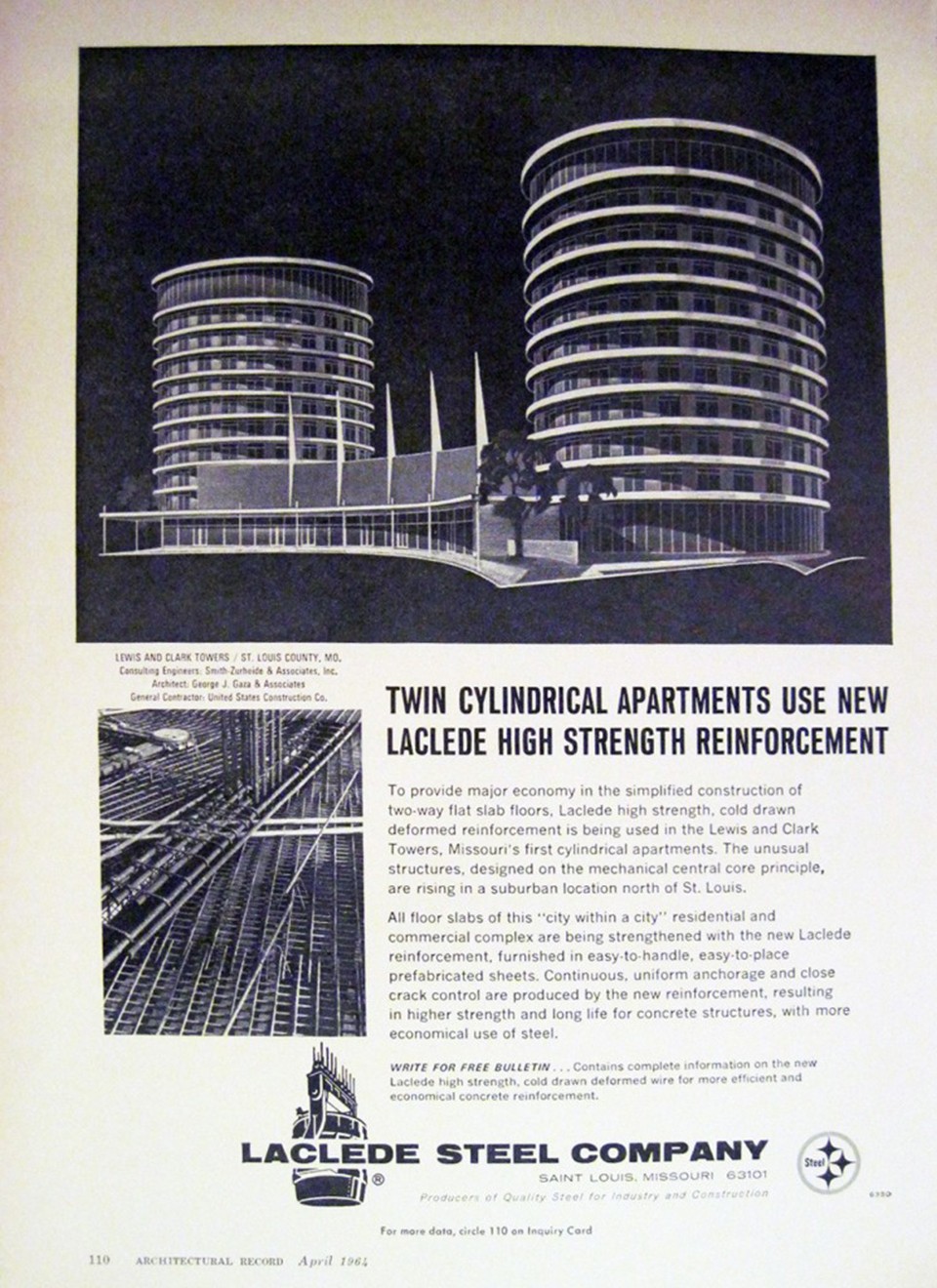
Architectural sketches Weiss posted on B.E.L.T. show a pair of alike buildings, with a single-story, multi-unit retail plaza running between the two anchors; the towers are described as featuring "St. Louis' first cylindrical apartments," which did come to pass, as did a single tower's completion. Its twin never came to be, presumably due to financial woes on the developer's part. So only a single, cylindrical tower was built, designed by architects George J. Garza & Associates, built by United States Construction Co., and featuring the output of the Laclede Steel Co. But the idea, footprint and ghost of that second tower remain today; looking at the plaza, you can see that the outermost business, Dowling Optometry, has both a slope and curve to its outer wall, with ample space for the missing ghost tower beside it.
Once you're aware of the intended second tower, you can't help but notice its non-presence on the site. But while that second tower wouldn't rise, there was a longtime subterranean life to the space. As Weiss wrote of the building's heyday:
In 1966, the place was 100 percent jumping with at least seven floors of wedge-shaped residential apartments (now condominiums,) each with two sliding doors out to the continuous balcony, with its own swimming pool and gym in the basement. Businesses on the first two floors of the Tower included Alpha Interior Designer, Donton & Sons Tile Co., Figure Trim Reducing, King's Tower Pharmacy and a Missouri State License office.
Shooting off the Tower is a strip of retail facing Hwy 367, long-anchored by Stelmacki Supermarket, a rare, independent grocer still unaffected by the continuous grocery wars. The site slopes down to the West, creating a lower 2nd level building which held the Towers Bowling Lanes and the Lewis & Clark Theater. Occupancy for the complex was robust for 10 years, with an influx of dentists and doctors filling tower spots when others moved out. The Courtesy Sandwich Shop even had a storefront for a bit. The Tower didn't show any longterm vacancies until the late 1970s.
In time, the submerged ground floor would become a pair of clubs: Animal House, an all-ages venue that birthed a significant number of notable St. Louis bands of the '80s and '90s, and Club 367, which was St. Louis' punk-and-metal linchpin during its too-brief lifespan. Eventually, that space became a flea market; today, it's just as condemned as the Tower, with busted police tape across the entryway and police units frequently circling the huge parking lot out back.
Our recent attempts to explore that particular space were foiled on a couple of occasions by the presence of Moline Acres' Finest. But the Tower itself is accessible.
While the front doors of the Lewis & Clark Tower are firmly sealed with an industrial-sized padlock-and-chain combo, entry to the building doesn't require a lot of work or innovation, as a large pane of glass just steps away has been smashed to bits. It's one of several entry points, and it's obvious from a self-guided tour that dozens of people have called this place "home" since the last official residents left in 2014 — this despite thousands of dollars in municipal funds for board-up efforts.
Just inside the doorway, a business directory in the curved lobby gives a decent sense of what was left when the building was emptied of both of residents and businesses. Paperwork, photos and other assorted detritus give a sense of lives lived in the nine lower floors (the restaurant took up all of the tenth).
See also: 15 Haunting Photos from Inside the Tower
The first, second and half of the third floors were occupied by businesses. And, just like the condos and apartments, each business was built to fit the unusual, rounded walls. Some of the bigger businesses had fewer walls and a more open floor plan, with a larger, suite-like feeling; others were contained to one room and these feel tiny, outmoded by modern standards. A former State Farm Insurance office has the most complete feel of all, as hundreds of pieces of correspondence, checkbooks, policies and other papers still litter the desks and shelves.
Like others in the building, this space has been ransacked, with almost every bathroom and kitchen wall featuring thin strips of demolition, where scrappers have obviously (and successfully) searched for copper. It's a pattern that continues on up to the residential floors, which extended from the hybrid commercial/residential third floor up to the ninth. Each story pinwheels out from the center, where a dual elevator system, two sets of steps and the building's HVAC, electrical and plumbing systems were found. These walkways, like the condos and businesses, have been liberally sacked, spray-painted, occupied and photographed by numerous urban explorers.
In the abandoned condos, especially, you get a sense of how quickly people left. Personal effects are everywhere. Photos and scrapbooks. Artwork. Furniture of all sorts. Books. Electronics. Toys. A little of everything's been left inside, almost all of it picked through over the years by urban explorers, graffiti taggers and the few dozen squatters who've called the Tower at least a temporary home and whose own lives here are told by small remains. They've left vials of pills, clothing piles made into bedding, trash bags of dried feces in countless toilets.
Lastly, all the way up, there's the Top of Tower Restaurant space within the building's tenth and final floor. Inside the once-posh restaurant, you can feel what was once a vivid example of mid-century style. Thick carpets remain, though filthy and mold-riddled now. Windows not spray-painted over the years offer the same wide views of the surrounding north-county landscape as seen on postcards of the glory days.
But like other floors, the air's thick in here; one member of our party picks up an immediate, mold-induced headache inside and the temps are colder by several degrees than outside.
We head out onto the roof, observing the Top of Tower Restaurant signage from here; every letter is remarkably still intact. Out here, the breeze is refreshing, life-affirming. Every other level of the building is filled with a sense of death; not necessarily of lives, but of bank accounts and dreams and better days. Out here, looking at the world, framed by those big, remaining block letters, you can't help but wonder, "What's next?"
At this point, no good answer to that question exists. And the mathematics to the equation have become somewhat muddied in recent years, as the plaza and Tower are now owned by different entities registered in California: The plaza's owned by Lewis & Clark 195 LLC of Long Beach, while the Tower is under the control of SNB Investing LLC of Newcastle.
Since 2008, Michele Deshay has been mayor of Moline Acres' 2,400 or so residents, serving on the city council since 2003. Her time in office has overlapped with the demise of the building, which has been blamed on many interlocking factors, most taking place outside of the town's compact city hall.
In fact, the Tower is something of a coat of many colors. Whatever you use to observe the region's relative strengths and weaknesses, well, you'll find elements of that worldview at this site. Overlays of race and class? Check. The effects of suburban decay where there was once mid-century progress? Check. Video cassettes killed movie theaters and people stopped bowling in leagues, you say? Many a book has been written. St. Louis County's 90 municipalities also are a talking point, as Moline Acres' small population and dwindled commercial base no longer offer the civic/financial oomph to restore the Tower to greatness.
Unknotting all of these elements is complex enough. Developing a renewal plan will be even more complicated, and Deshay is frank in saying that there's no easy answer.
There is, though, a sense of civic loss.
"It's disappointing and depressing and everything else when you look at this building sitting in the state that it's in," Deshay says. "We're a small city and we don't have the resources to do much more than we have. We try to go ahead and spend; we've used around $6,000 to $7,000 of city funds to keep it boarded up and to keep it from not being a dump, but that's what it's turned into. St. Louis County is pretty much what you'd call 'not wanting' to put in more money.
"The status of the building is that it's condemned," she says. "At this point in time, it's just condemned. People didn't pay their taxes or condominium fees; there should be about 90 units in there, with all the townhouses and condominiums. I don't know when things exactly started going wrong, but as people were leaving them, times were changing and the condo association just disbanded. Some people were paying in, some weren't; others were renting out their units and making money that way. We were caught in the middle, as a city, trying to see about putting the building into a trust, or simply to see what the owners wanted to do with it. After a while, no one was trusting anyone else with their money."
Once aimed at a cool, cosmopolitan-in-the-suburbs type of resident, the Tower became a less desirable property over time. Condo prices fell and, towards the end, a block of 21 units were being offered at just $11,000 each, a far cry from the earlier values. As the residential population became more transient, temporary and low-income, the in-building services, somewhat predictably, began to dissolve.
That caused a situation that dissolved five years ago into not only a quality-of-life issue for residents, but a potentially life-threatening one.
Nita Carnes was among the last people to move, "though a few stragglers stayed on" until condemnation forced them out in 2014. Her unit, she says, had "been without water for three years," with baths and kitchen needs requiring daily rounds of boiling water.
Even before that, the Tower was no Eden. Carnes recalls that the relatively thin walls of the complex made things problematically loud and that there wasn't any sense of community among the residents. Still, she says, "you made your own positives out of the situation."
By the end days, the pair of elevators were in and out of operation and the mostly older residents were forced to haul their belongings up and down the steps. The businesses and offices were increasingly occupied by social service providers, rather than for-profit operations. The remaining amenities had disappeared. Officials in 2014 were forced to evacuate the final residents, even as ownership claims for the individual units were slowing that process.
What's left is a jumble of messes: legal, structural and financial.
"People here want someone to step and take responsibility," says Deshay. "My position on the building right now is that it would take a lot of money to re-do what's been done. The building's severely deteriorated; it's a big eyesore for north county. I have been in talks with the county council, and the consensus is that we, as a city, can't maintain it. We can try to keep people out of it by boarding up the two bottom floors; we've had someone walk through every floor and close the doors."
These are temporary fixes, if that. Deshay would prefer for someone to acquire the building, someone who "has an actual plan for those acres of land. Either that, or tear the building down, honestly. I don't see how it could be restored. It was nice when it was up and going — I do remember the time when limousines were driving up on a Saturday night. There was the swimming pool in the basement. It was like living in our own little city."
Interestingly, when Carnes hears that there was a pool in the basement, she's somewhat surprised.
A multi-year resident of the space, she says, "I thought that only was a myth."
The notion of myths, of what-ifs, is a constant refrain when it comes to Lewis & Clark Tower's future, with business owners in the plaza either declining conversations about it or wishing to speak off the record. There's a sense that the building is there for now, it's not going anywhere anytime soon, and the best that can be hoped for is a demolition, at some point.
When told what this story is about, Tom Stelmacki says, without anger, "Well, I have no idea. You're talking to the wrong person about that."
He adds, bluntly, "I wish they'd tear it down today. It's an eyesore. It was an eyesore at the end of its days and wasn't being taken care of. The back of the building is a complete mess; people are dumping trash all over. The back parking lot is beat up. The city's talking about about wanting to do something. Maybe a new strip center, maybe getting rid of this whole thing."
But the adjacent plaza, he says, remains a place of commerce, despite the decay next door. "It's always been full; just a couple tenants have left. But you come in here on a Friday afternoon or Saturday morning, and our whole parking lot's full. There are a lot of tax dollars going to the city from this building.
"The word, I think, is 'frustrating' for our part," he says. "I think for everybody's part. No one knows what they can do. I'm not a lawyer and don't known the legalese of eminent domain. Maybe the city, working with the county, could work something out to get the thing torn down."
Weiss foresees just that fate. "That building is a goner," she writes in an email exchange. "When even Moline Acres city hall wants it gone, it's a goner."
"I drive by at least once every two months on my way to Alton," she adds. "Its rapid decline is nauseating! The first time I saw the first bit of graffiti on the top floor my heart sank. As that graffiti spread across the entire tower, coupled with broken glass, my heart broke. I now drive by and moan. The last time I pulled in for updated photographs, I had tears streaming down my face. It just hurts."
For Weiss, though, the Tower's fate isn't singular. Moline Acres has a story. The neighboring municipalities have a story. As the years pass, residential and shopping trends change, buildings fall and examples of the region's mid-century modern past dim or disappear outright.
On her blog, she reminisces about losing a nearby neighbor, the Lewis & Clark branch of the St. Louis County Library system.
"They tore down the old one to build the new," she explains in an email. "That was, literally, an important piece of NoCo childhood extinguished. And as I'd watch them tear down the old library, I'd look up the hill and see the Tower being destroyed by disregard, and my heart hurt for Moline Acres' past and present. Which is odd, because the library — ultimately — was a GOOD thing, investing in the future. But they didn't need to kill its past to welcome the future. There's so much wonderful history and [mid-century modern] architecture along Chambers Road in that area. Some of it is being kept up and utilized. Others are decaying, and it's sad. At this point, it'd be nice to raze them for some new pre-fab business buildings. I hold onto hope that it will happen. What other choice is there BUT hope?"
Stelmacki hears that concern and gets it. But he hears from plenty of people, with a variety of desired outcomes. Nostalgia plays a strong role in the conversation, no doubt.
"A lot of people," he says, "would like to see someone still do something with it. The feedback I get from customers is that they remember it from when they were little kids. 'I remember the Tower. Why can't they do something? There's no reason for a building that we're all used to seeing fall apart.' And it was a beautiful building, very well taken care of. There were neon lights and a big canopy out here. The theater's billboard was lit up, showing what was playing in back. That sign was right out here, in the grass out front.
"But the longer the Tower sits, the worse it gets. In the beginning, it might've still been manageable. That was the time to do something. An owner could've bought the building for nothing, dumped some money into it and had something. Now it's too far gone. Now it's all about how we're going to demolish it. What else can we do with it?"
Stelmacki is one of eight siblings, four of whom still work at the grocery store. He grew up in the 53-year-old business. "I can walk out into the store and greet five shoppers by name."
But when he walks into the building, he aims not to look left. Something in that direction grates at him, daily.
"I try not to look at it," he says of his crumbling, iconic neighbor. "I try to not even see it."
See also: 15 Haunting Photos from Inside the Tower

